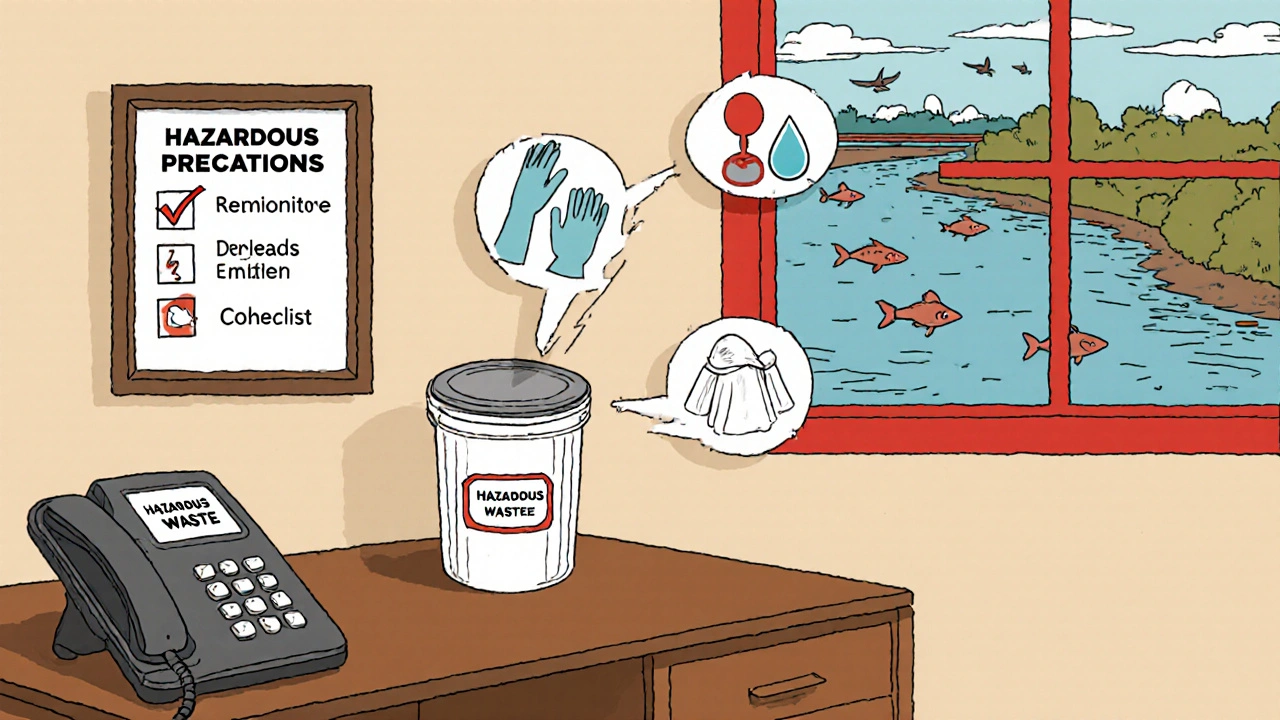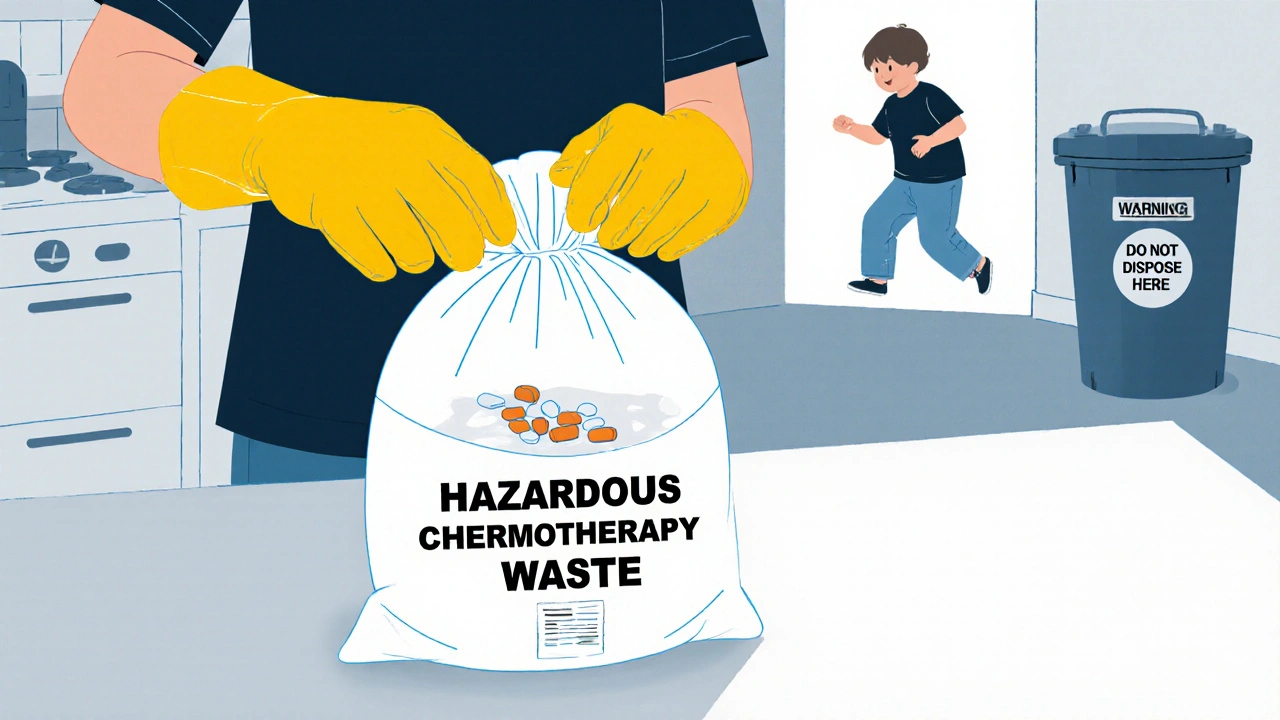Why Chemotherapy Medication Can’t Be Thrown in the Trash Like Regular Pills
Most people know not to flush old pills down the toilet. But chemotherapy drugs are a different kind of danger entirely. These aren’t just strong painkillers or antibiotics-they’re powerful cancer-fighting chemicals that can damage DNA, harm unborn babies, and pollute water for years. Even tiny amounts left on gloves, in empty bottles, or in urine can be harmful. If you’re taking chemotherapy at home, you’re not just managing your own treatment-you’re handling something that requires special care to protect your family, your neighbors, and the environment.
What Makes Chemotherapy Waste So Dangerous
Chemotherapy drugs are designed to kill fast-growing cells. That’s why they work against cancer. But they don’t know the difference between a tumor and your hair follicles, gut lining, or a child’s developing body. These drugs stay active in your body for up to 72 hours after you take them. That means your sweat, urine, vomit, and even feces can contain traces of the medicine. If you flush a pill or toss a used syringe in the regular trash, someone else-maybe a sanitation worker, a pet, or your toddler-could be exposed. The EPA found detectable levels of cyclophosphamide, a common chemo drug, in two-thirds of U.S. waterways. That’s not a guess. That’s science.
What You Must Do Before Handling Any Chemo Medication
Before you even open a bottle, put on disposable nitrile gloves. Not latex. Not kitchen gloves. Nitrile, at least 0.07mm thick. These gloves block chemicals that regular gloves won’t. Keep a fresh pair nearby for every step: opening the bottle, counting pills, cleaning spills, or handling used tissues. Never reuse gloves. Never wash them. Never touch anything else while wearing them. After you’re done, take them off carefully-don’t pull them inside out-and throw them in a sealed plastic bag. The same goes for any clothing that comes into contact with the medication. Wash those separately from the rest of your laundry.
How to Dispose of Oral Chemo Pills (Tablets and Capsules)
Never crush, break, or chew chemo pills. Even dust from a broken tablet can be dangerous. If you’re prescribed a capsule, swallow it whole. If you can’t swallow it, talk to your nurse before doing anything else. For disposal, place unused or expired pills directly into a leak-proof plastic bag. Don’t mix them with coffee grounds or cat litter like you would with regular meds-that’s not enough protection. Use a double-bag system: put the pills in the first bag, seal it tightly with a zip tie or knot, then place it inside a second identical bag. Seal that one too. Label it clearly: "Hazardous Chemotherapy Waste." Keep it out of reach of children and pets until you can hand it over to your healthcare provider or a certified collection site.
What to Do With Transdermal Patches
Chemo patches stick to your skin and release medicine slowly. When it’s time to remove one, fold it in half so the sticky sides touch. This traps the drug inside. Then put it in the same double-bag system as your pills. Never flush a patch. Never throw it in the trash unfolded. Even a used patch can still hold enough medicine to cause harm if someone finds it. If you’re unsure whether the patch is fully used, ask your nurse. Some patches need to be returned to the pharmacy for proper disposal.

Liquid Chemo and IV Bags: A Step-by-Step Guide
If you’re administering liquid chemo at home, you’ll likely have syringes, IV bags, or tubing. These are high-risk items. After use, place them immediately into a rigid, yellow hazardous waste container-these are usually provided by your hospital or clinic. If you don’t have one, use a sturdy plastic bottle with a tight cap (like a laundry detergent bottle), label it clearly, and keep it sealed. Never pour liquid chemo down the sink or toilet. If a spill happens, follow the 15-step cleanup procedure from the Cancer Institute of New Jersey: wear gloves, gown, face shield, and mask. Use disposable cloths, not paper towels. Don’t vacuum or sweep-it spreads particles into the air. Seal everything used in cleanup in the double-bag system. Clean the area afterward with plain water and soap. Don’t use bleach-it can react dangerously with chemo drugs.
What You Can’t Use for Safe Disposal
Many people assume common disposal tools work for chemo. They don’t. The Deterra® system, which deactivates regular medications with activated carbon, is explicitly not approved for chemotherapy. MedDrop kiosks accept only about 63% of chemo drugs-many are excluded. Mail-back programs? Only 28% of U.S. pharmacies offer them for chemo waste. Community take-back events? Only 12% will accept chemotherapy because of the risks to volunteers. Flushing? Absolutely forbidden. Even if the FDA says you can flush certain opioids, they say never flush chemotherapy. And never mix chemo waste with regular household trash. The risks are too high.
How Long Do You Keep Taking Precautions?
You can’t stop being careful just because your treatment session is over. The American Cancer Society says active chemo drugs can stay in your body fluids for up to 7 days. For the first 48 to 72 hours after each dose, treat everything you touch as contaminated. Use separate towels, wash your hands after using the bathroom, and flush the toilet twice after use. If you have a pet, keep them away from your bathroom for a few days. Your nurse should give you a checklist for this period. Stick to it. Even if you feel fine, the drugs are still in your system.
Where to Take Your Waste
Your oncology team should give you a plan for disposal. Most hospitals provide pre-labeled hazardous waste containers for return. Some offer mail-back envelopes. Others partner with companies like Stericycle to collect waste from your home. Ask your nurse: "Where do I return this?" If you’re not sure, call your pharmacy or cancer center. Don’t wait. Don’t store it under the sink. If you’re in the UK, contact your local NHS trust-they have specific programs for hazardous drug return. In the U.S., check if your state has a chemotherapy disposal law. Only 19 states do. But federal rules are changing. The Cancer Drug Disposal Act of 2021 is moving through Congress and could create nationwide standards soon.

What to Do If You’re Not Sure
If you’re confused, overwhelmed, or scared you’ve made a mistake, call your oncology nurse. They’ve seen this before. They won’t judge you. They’ll help you fix it. Most hospitals have a 24/7 nurse line for exactly this kind of question. Don’t guess. Don’t rely on Google. Don’t assume your neighbor’s advice is safe. The right answer is always: "Ask your care team." And if you’re not getting clear instructions, ask again. You have the right to safe, clear guidance.
Why This Matters Beyond Your Home
Improper disposal doesn’t just put your family at risk. It affects everyone. When chemo drugs enter water systems, they don’t disappear. Fish, frogs, and birds are exposed. Drinking water supplies can be contaminated. Healthcare workers who handle trash from homes without proper disposal are at higher risk of long-term health problems. A 2022 report found that 78% of healthcare providers believe home chemo disposal is a "significant or extreme risk." That’s not fear. That’s evidence. When you dispose of chemo correctly, you’re not just protecting yourself. You’re protecting public health.
What’s Changing in the Next Few Years
More chemo is being given at home than ever before. The market for home cancer treatment has grown nearly 30% since 2019. That means more waste-and more risk. The FDA now requires all oral chemo drugs to include disposal instructions on the label. The EPA has allocated $4.7 million to find better ways to handle this waste. New technologies are in testing, like the ChemiSafe system and the Oncology Waste Management Unit. But until those arrive, your actions today make the biggest difference. You’re not just a patient. You’re part of the solution.
Key Takeaways
- Never flush, crush, or throw chemo pills in the regular trash
- Always use double-bagging with leak-proof plastic bags
- Wear nitrile gloves every time you handle medication or waste
- Keep precautions active for 48-72 hours after each dose
- Return waste to your hospital, clinic, or approved collection point
- Ask your nurse if you’re unsure-never guess
Can I mix chemotherapy waste with regular household trash?
No. Chemotherapy waste must be kept separate from regular trash because it can expose sanitation workers, pets, and children to harmful chemicals. Always use a double-bag system and return it to your healthcare provider or an approved hazardous waste collection site.
Is it safe to use the Deterra® system for chemotherapy drugs?
No. The Deterra® system is only approved for non-hazardous medications like painkillers and antibiotics. Its manufacturer explicitly states it is not safe for chemotherapy drugs, which require more advanced containment methods.
How long do chemo drugs stay active in my body?
Active chemotherapy drugs can remain in your urine, sweat, and vomit for up to 72 hours after treatment, and sometimes as long as 7 days. During this time, treat all bodily fluids and contaminated items as hazardous.
Can I flush chemotherapy pills if they’re on the FDA’s flush list?
No. The FDA’s flush list applies only to certain non-hazardous medications like opioids. Chemotherapy drugs are never approved for flushing, regardless of what the label says. Flushing them contaminates water supplies and violates EPA regulations.
What should I do if I spill chemotherapy liquid at home?
Put on gloves, a gown, face shield, and mask. Use disposable cloths to wipe up the spill-never paper towels or a vacuum. Seal all cleanup materials in a double-bagged plastic container. Wash the area with soap and water. Contact your oncology team for further instructions.
Are there free disposal programs for chemotherapy waste?
Yes. Most hospitals and cancer centers provide free hazardous waste containers and return programs for patients receiving home chemotherapy. Ask your nurse or pharmacy for details. Some states and nonprofits also offer mail-back or drop-off services at no cost.
Why can’t pharmacies take back chemotherapy drugs like they do with other medications?
Most pharmacies aren’t equipped to handle hazardous chemo waste. It requires special training, containers, and disposal permits. Only about 34% of U.S. pharmacies accept chemotherapy waste, compared to 92% that take back regular medications.
What if I run out of disposal bags or gloves?
Call your oncology nurse or pharmacy. They’re required to provide replacement supplies at no cost. Don’t use household containers or regular gloves-they won’t protect you. Most providers send replacement kits monthly or as needed.
